
Tipu Sultan, commonly referred to as Sher-e-Mysore or "Tiger of Mysore", was the Indian Muslim ruler of the Kingdom of Mysore based in South India. He was a pioneer of rocket artillery. He introduced a number of administrative innovations during his rule, including a new coinage system and calendar, and a new land revenue system, which initiated the growth of the Mysore silk industry. Tipu was also a pioneer in introducing Channapatna toys. He expanded the iron-cased Mysorean rockets and commissioned the military manual Fathul Mujahidin, He deployed the rockets against advances of British forces and their allies during the Anglo-Mysore Wars, including the Battle of Pollilur and Siege of Srirangapatna.
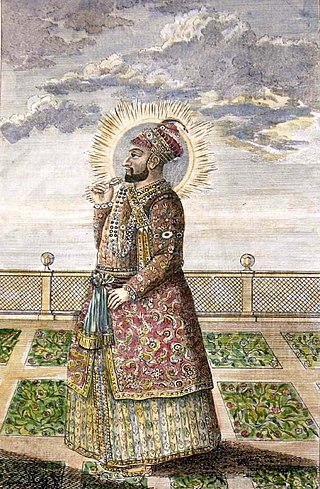
Hyder Ali was the Sultan and de facto ruler of the Kingdom of Mysore in southern India. Born as Hyder Ali, he distinguished himself as a soldier, eventually drawing the attention of Mysore's rulers. Rising to the post of Dalavayi (commander-in-chief) to Krishnaraja Wodeyar II, he came to dominate the titular monarch and the Mysore government. He became the de facto ruler of Mysore as Sarvadhikari by 1761. During intermittent conflicts against the East India Company during the First and Second Anglo–Mysore Wars, Hyder Ali was the military leader.
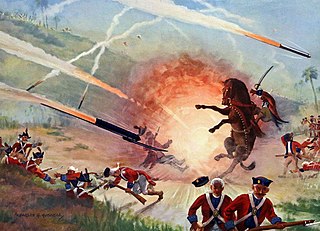
The Battle of Pollilur, also known as the Battle of Polilore or Battle of Perambakam, took place on 10 September 1780 at Pollilur near Conjeevaram, the city of Kanchipuram in present-day Tamil Nadu state, India, as part of the Second Anglo-Mysore War. It was fought between an army commanded by Tipu Sultan of the Kingdom of Mysore, and a British East India Company force led by William Baillie. The EIC force suffered a high number of casualties before surrendering. It was the worst loss the East India Company suffered on the subcontinent until Chillianwala. Benoît de Boigne, a French officer in the service of 6th Regiment of Madras Native Infantry, wrote, "There is not in India an example of a similar defeat".
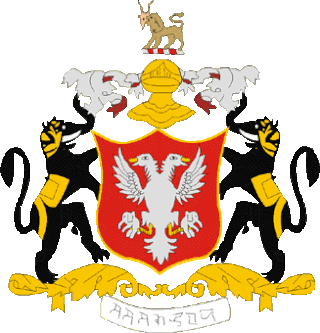
The Wadiyar dynasty, is a late-medieval/early-modern South Indian Hindu royal family of former kings of Mysore from the Urs clan originally based in Mysore city.

The Kingdom of Mysore was a realm in southern India, traditionally believed to have been founded in 1399 in the vicinity of the modern city of Mysore. From 1799 until 1950, it was a princely state, until 1947 in a subsidiary alliance with British India. The British took direct control over the princely state in 1831. Upon accession to the Dominion of India, it became Mysore State, later uniting with other Kannada speaking regions to form the state of Karnataka, with its ruler remaining as Rajapramukh until 1956, when he became the first governor of the reformed state.

The Second Anglo-Mysore War was a conflict between the Kingdom of Mysore and the British East India Company from 1780 to 1784. At the time, Mysore was a key French ally in India, and the conflict between Britain against the French and Dutch in the American Revolutionary War influenced Anglo-Mysorean hostilities in India. The great majority of soldiers on the company side were raised, trained, paid and commanded by the company, not the British government. However, the company's operations were also bolstered by Crown troops sent from Great Britain, and by troops from Hanover, which was also ruled by Great Britain's King George III.

The First Anglo-Mysore War (1767–1769) was a conflict in India between the Sultanate of Mysore and the East India Company. The war was instigated in part by the machinations of Asaf Jah II, the Nizam of Hyderabad, who sought to divert the company's resources from attempts to gain control over the Northern Circars.

The Anglo-Mysore Wars were a series of four wars fought during the last three decades of the 18th century between the Sultanate of Mysore on the one hand, and the British East India Company, Maratha Empire, Kingdom of Travancore, and the Kingdom of Hyderabad on the other. Hyder Ali and his succeeding son Tipu fought the wars on four fronts: with the British attacking from the west, south and east and the Nizam's forces attacking from the north. The fourth war resulted in the overthrow of the house of Hyder Ali and Tipu, and the dismantlement of Mysore to the benefit of the East India Company, which took control of much of the Indian subcontinent.
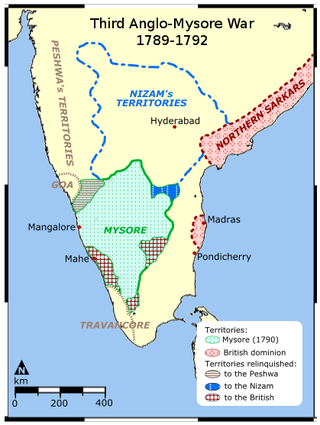
The Third Anglo-Mysore War (1790–1792) was a conflict in South India between the Kingdom of Mysore and the British East India Company, the Kingdom of Travancore, the Maratha Empire, and the Nizam of Hyderabad. It was the third of four Anglo-Mysore Wars.

The maharaja of Mysore was the king and principal ruler of the southern Indian Kingdom of Mysore and briefly of Mysore State in the Indian Dominion roughly between the mid- to late-1300s and 1950. The maharaja's consort was called the maharani of Mysore.

The History of Mangalore dates back to the 3rd century BC and has been ruled by a number of rulers. In the era of modern India, the area was controlled by the Portuguese in Goa and Bombay, who lost it to Shivappa Nayaka, who in turn lost it to Hyder Ali.

The political history of Mysore and Coorg (1761–1799) is the political history of the contiguous historical regions of Mysore State and Coorg province on the Deccan Plateau in west-central peninsular India from the time of the rise of Haidar Ali in 1761 to that of the death of his son Tipu Sultan in 1799.
The Maratha–Mysore Wars were a conflict in 18th century India between the Maratha Empire and the Kingdom of Mysore. Though initial hostilities between the sides started in 1770s, the last battle began on February 1785 and ended in 1787.
The Siege of Tellicherry was a military embargo that happened in Thalassery. The Commander in Chief of the Mysore Calicut Province, Sirdar Ali, took siege of the British Military Barrack of Thalassery for 18 months. They British and the local administrators were blockaded within Thalassery by land as well as by sea. It was during the Second Anglo-Mysore War. The siege continued until reinforcements from Bombay under the command of Major Abington attacked the Mysore army and defeated them. Major Abington then moved south, capturing Calicut. The Siege of Tellicherry led to the fall of strongholds of the First Mysore conquest, led by Hyder Ali. Even though laterTipu Sultan came from Mysore to reinstate the conquered area to previous status.

The Mysorean invasion of Malabar was the military invasion of the Malabar region of Kerala, including the territories of the Zamorin of Calicut, by the then-de facto ruler of the Kingdom of Mysore, Hyder Ali. After the invasion, the Kingdom of Cochin to the south of Malabar became a tributary state of Mysore.

The Kozhikode, also known as Calicut, was the kingdom of the Zamorin of Calicut, in the present-day Indian state of Kerala. Present-day Kozhikode is the second largest city in Kerala, as well as the headquarters of Kozhikode district.

The States Reorganisation Act, 1956 was a major reform of the boundaries of India's states and territories, organising them along linguistic lines.
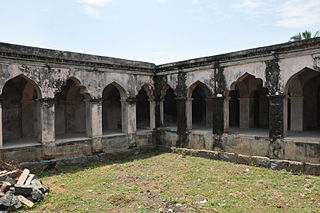
Attur Fort is a historic fort present in Attur in Salem district in the South Indian state of Tamil Nadu. The fort is located on the banks of river Vashista, 56 km (35 mi) away from Salem.The fort was built by a Palaiyakkarar chieftain Gatti Mudaliar dynasty under Madurai Nayaks, called Lakshmana Nayakan during the 17th century.

The Battle of Tiruvannamalai is one of the two successful battles fought by the Madras Army in the Carnatic along with the Battle of Chengam. It was fought on 25 September 1767 between the allied forces led by the East India Company against the troops of Hyder Ali. The allied forces of the English army were led by Colonel Smith.
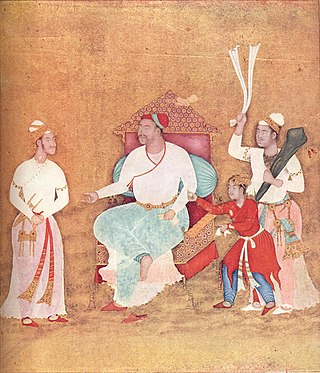
The Deccanis or Deccani People are an ethnoreligious community of Urdu-speaking Muslims who inhabit, or trace their ancestry from, the Deccan region of Southern and Central India, and speak the Deccani dialect. The community traces its origins to the shifting of the Delhi Sultanate's capital from Delhi to Daulatabad in 1327 during the reign of Muhammad bin Tughluq. The migration of Hindavi-speaking people to the Deccan, and the conversion of local Hindus to Islam, led to the creation of a new community of Urdu-speaking Muslims, known as the Deccani, who would come to play an important role in the politics of the Deccan. Their language, Deccani Urdu, emerged as a language of linguistic prestige and culture during the Bahmani Sultanate, further evolving in the Deccan Sultanates.































